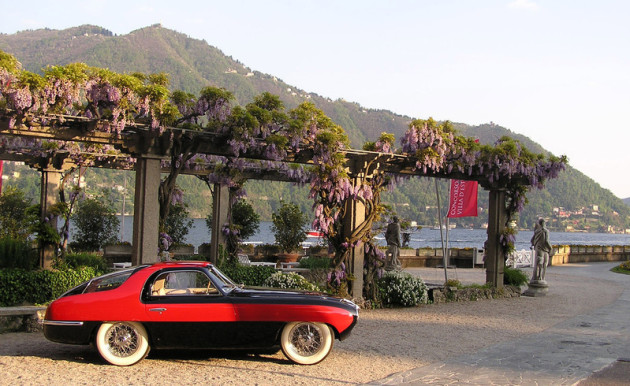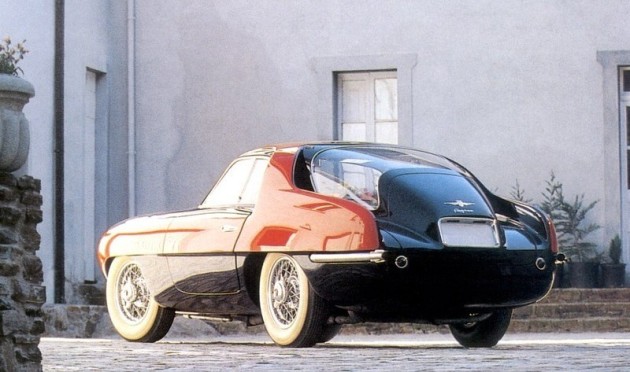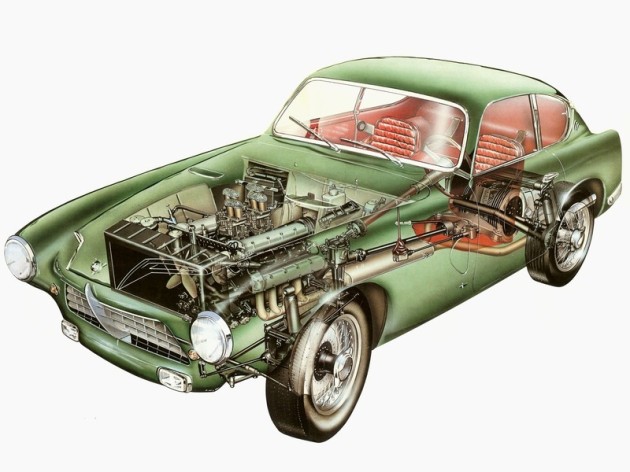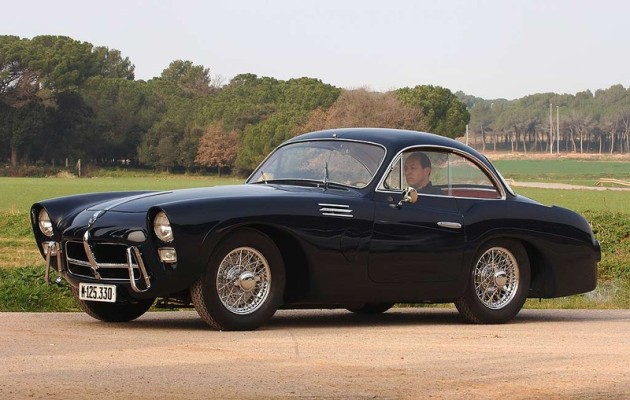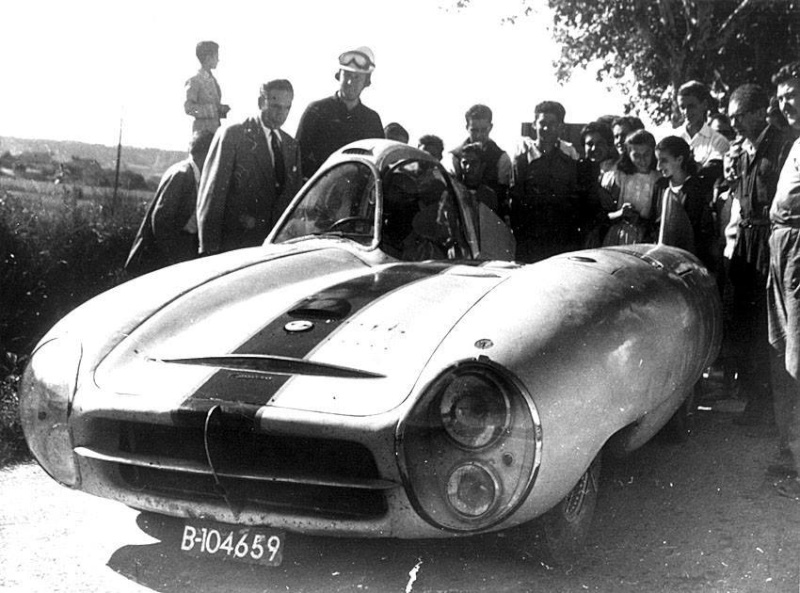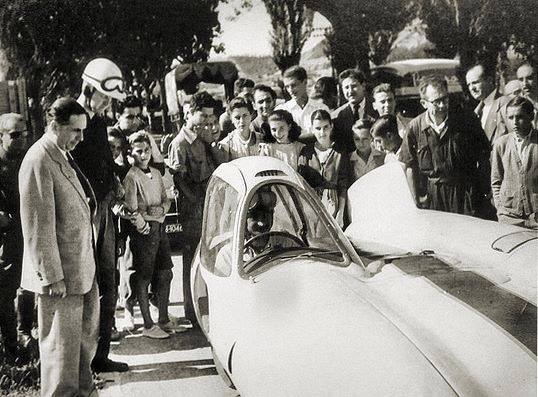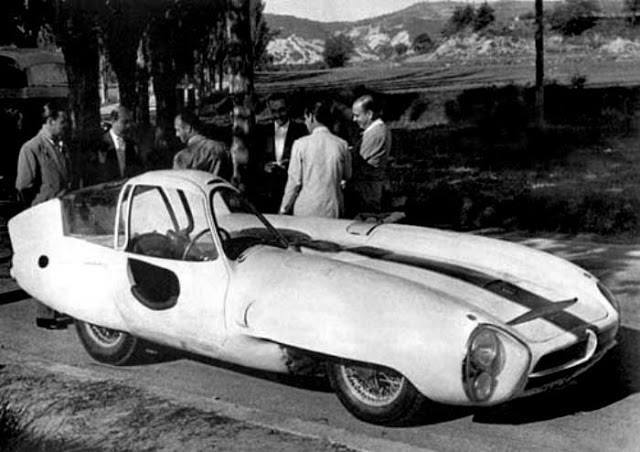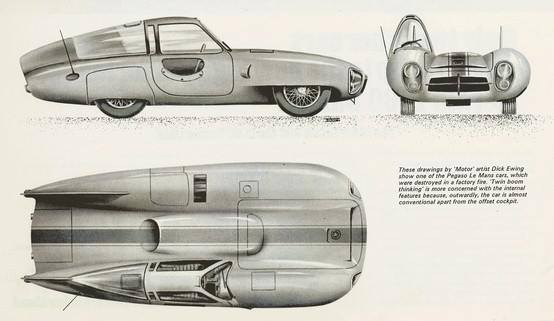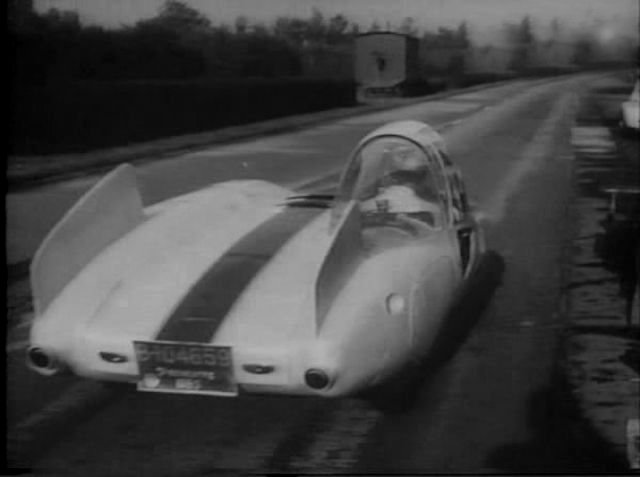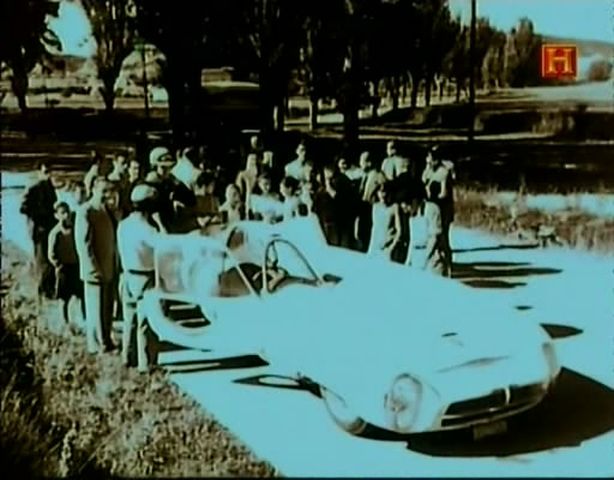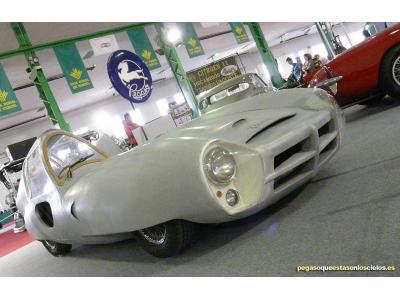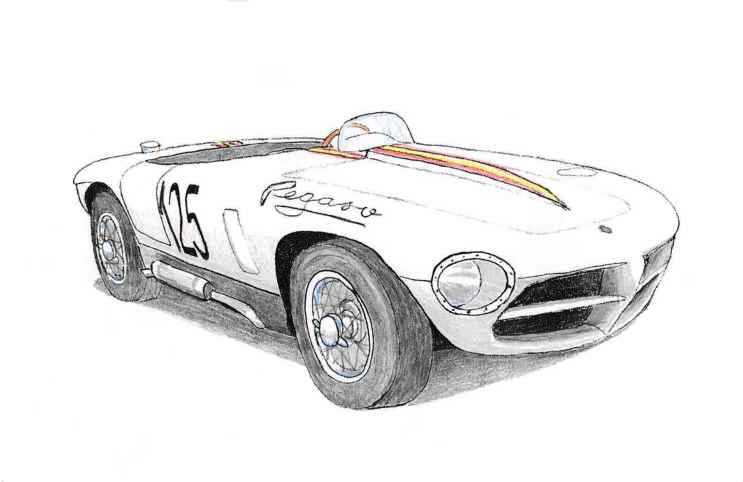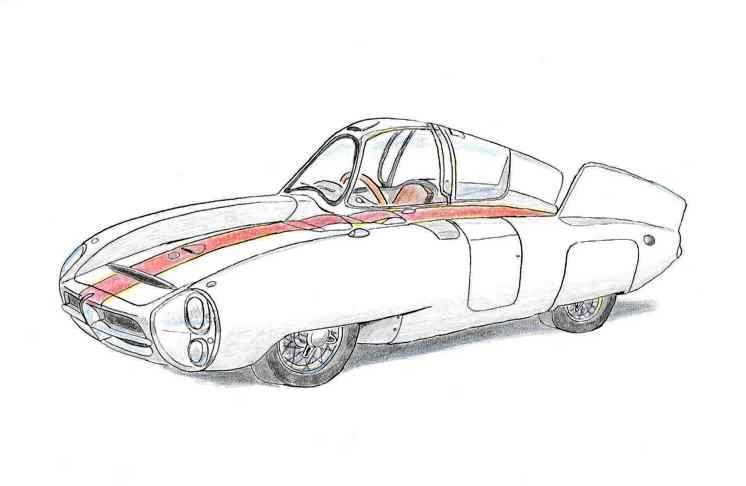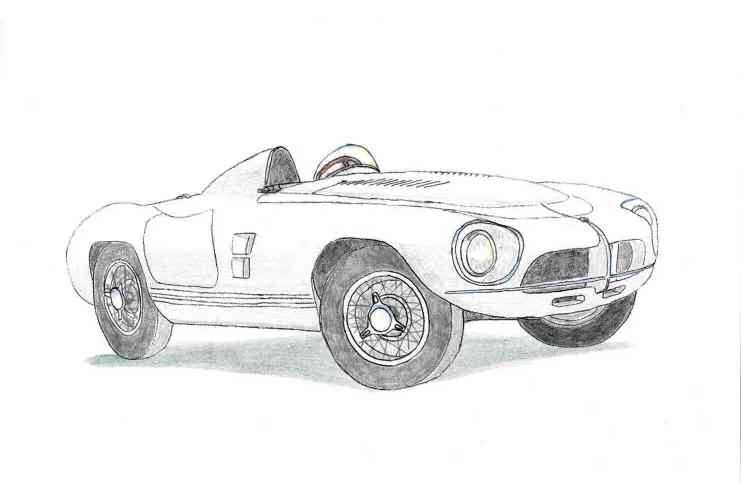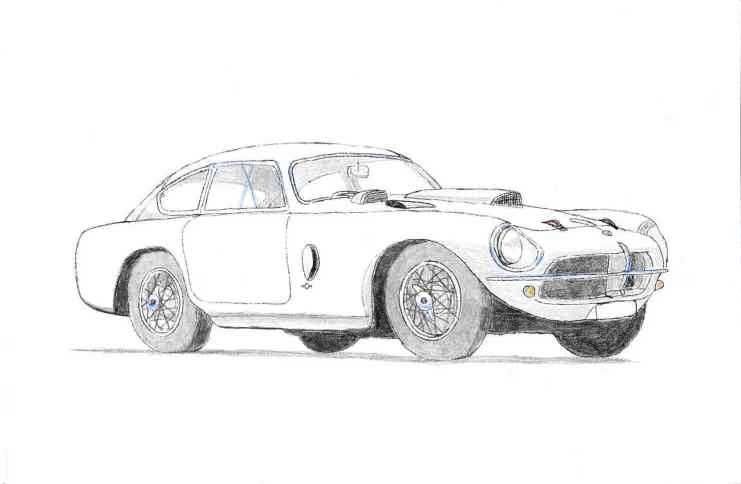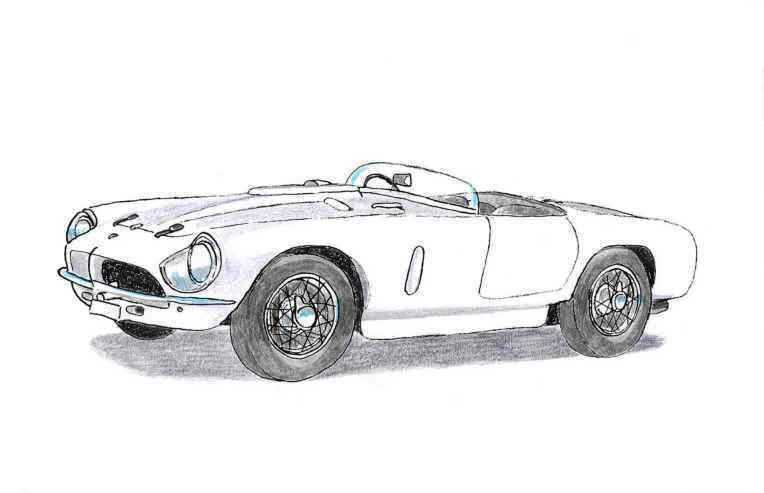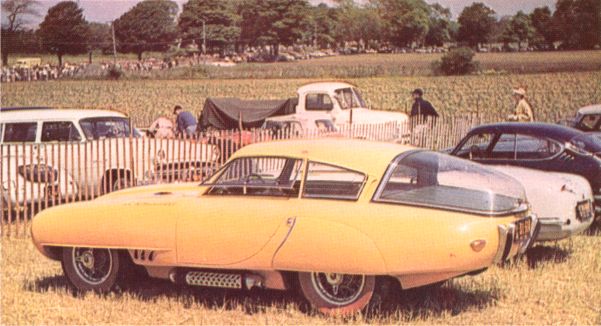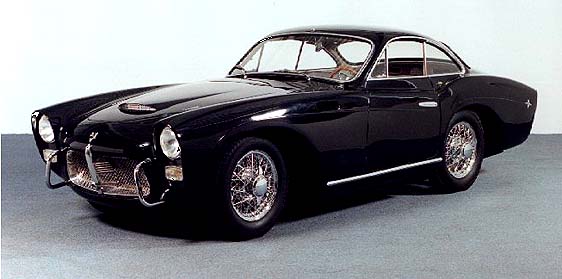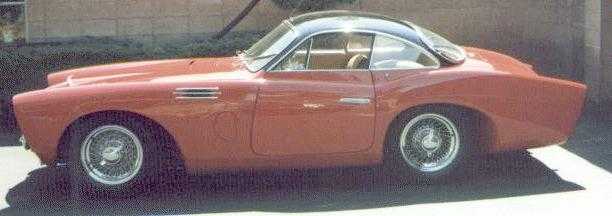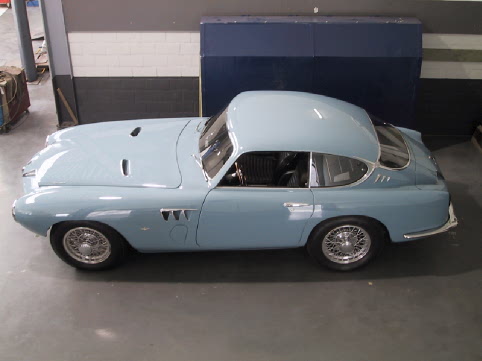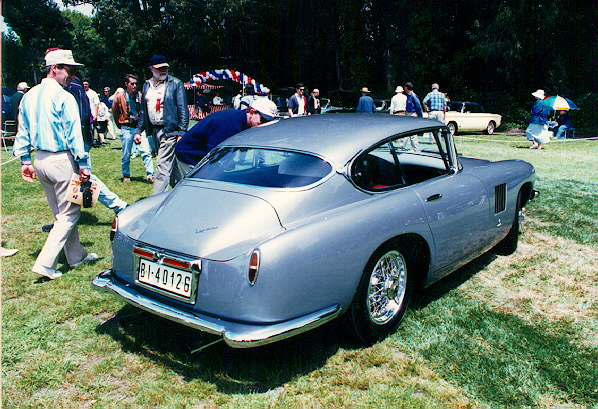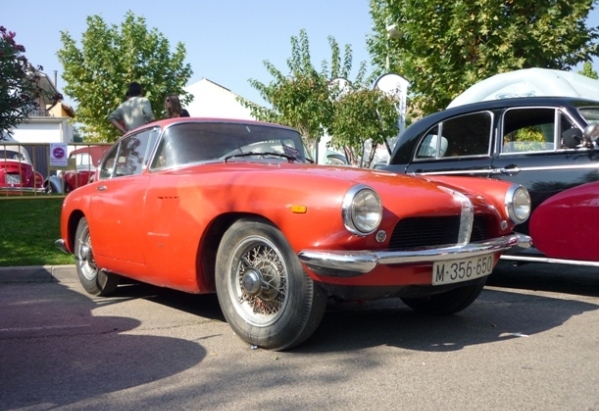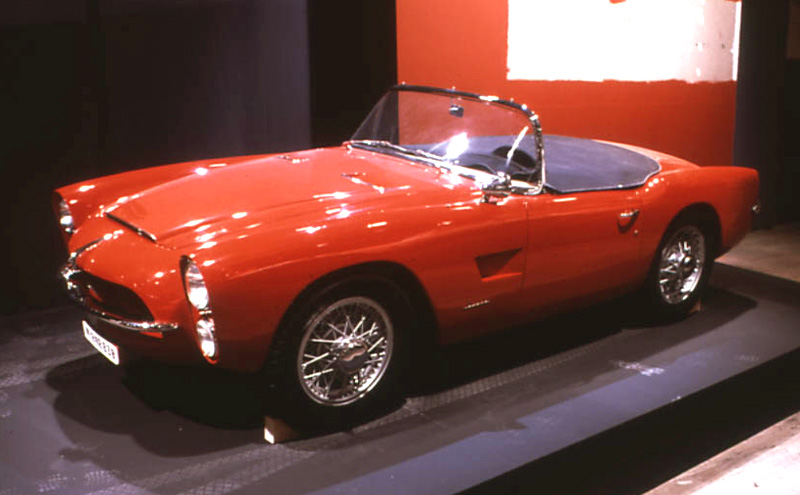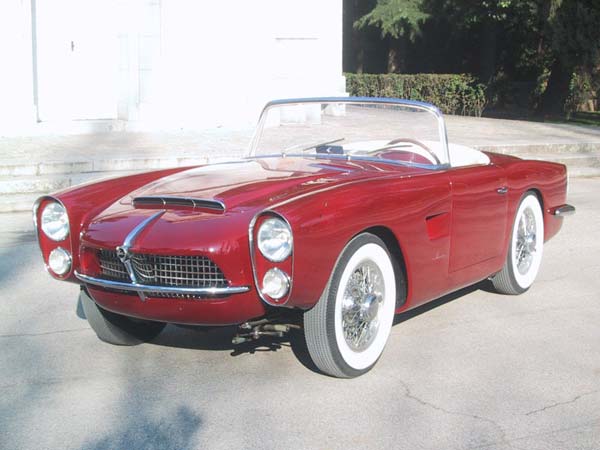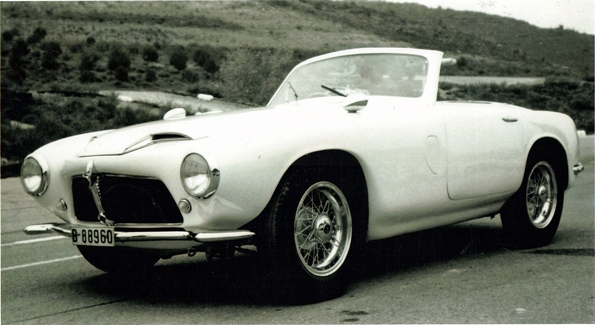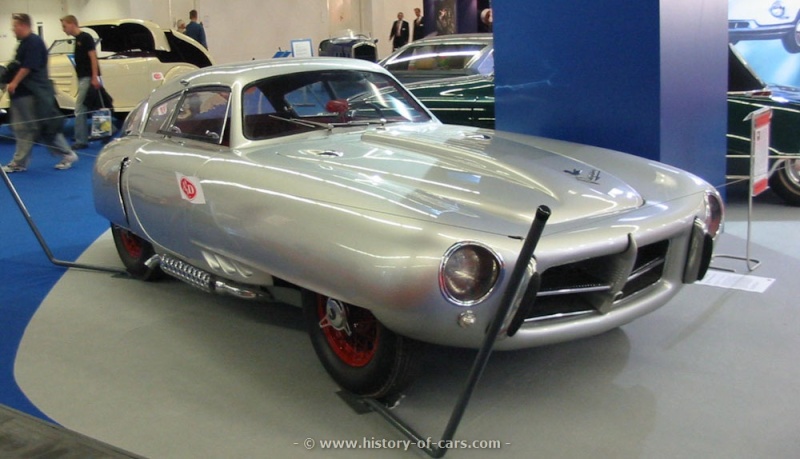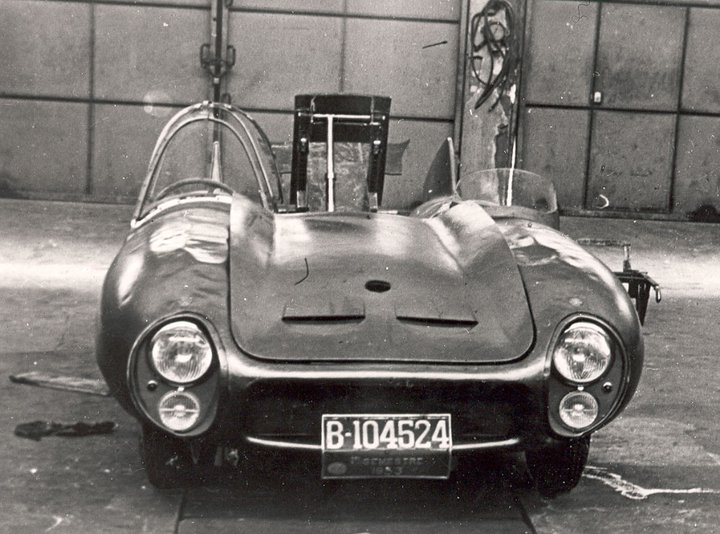Pegaso Z 102 (1951-1958)
3 participants
 Pegaso Z 102 (1951-1958)
Pegaso Z 102 (1951-1958)
http://stubs-auto.fr/p/pegaso-z-102-1951-1958/

1953 Pegaso Z 102 'Thrill' Touring.
Publié par Philippe Baron le 29 mars 2014.
Présentée au Salon de Paris 1951, la Pegaso Z 102 est la première voiture de l’après-guerre conçue et entièrement fabriquée en Espagne. Sa conception d’avant-garde relève de la technique sophistiquée de compétition mise au point par Wilfredo Ricart. L’ingénieur barcelonais tire ainsi profit de son expérience acquise chez Alfa Roméo à la fin des années 30. L’auto la plus chère du Grand Palais deviendra aussi en 1952 la voiture commercialisée la plus rapide au monde avec la Ferrari 340 America.

Pegaso Z 102 Cabriolet Saoutchik
En 1919, l’espagnol Wifredo Ricart, âgé de 22 ans, s’associe et fonde la marque Ricart et Perez. Il conçoit alors des voitures de course et de tourisme qui impressionneront Ugo Gobbato, ancien haut responsable de la Fiat, devenu le patron d’Alfa Romeo. Lorsque la marque au trèfle se lance dans un programme course intégré à l’entreprise, l’italien fait appel, non pas à Enzo Ferrari alors en charge de l’écurie de course rattachée à la marque, mais à Wilfredo Ricart qui dessinera la fameuse Tipo 512 à moteur central 12-cylindres de Grand Prix en 1940. De retour en Espagne après la guerre, l’INI (Institudo Nacional de Industria) lui propose de participer au plan de réorganisation de l’industrie automobile du pays. Une nouvelle entité est créée, l’ENASA (Empressa Nacional de Autocamiones) pour relancer en priorité la fabrique de camions et de bus sous la marque Pegaso. Parallèlement, Franco autorise à Ricart la création du CETA (Centro Technicos de Automocion) pour le projet d’une voiture de Grand Tourisme. C’est ainsi que nait le projet de la Z-102 (Z prononcé céta en espagnol) en référence au CETA et 102 pour deuxième projet.
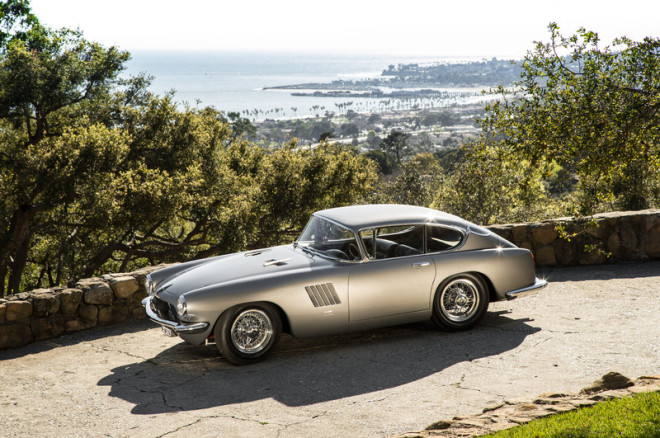
1956 Pegaso Z 103 Panoramica - Photos : Julia LaPalme
La Pegaso Z-102 se révèle comme une routière aux caractéristiques mécaniques relevant de la compétition. D'une conception d'avant-garde, le V8 de 2.5 litres en aluminium est doté de soupapes d'échappement creuses au sodium (plus vite refroidies), de pistons en aluminium forgé, d'un graissage à carter sec et d’une distribution qui se fait par quatre arbres à cames en tête entraînés par pignons. La Pegaso reçoit selon le choix du client un ou deux carburateurs. Avec des cotes super carrées (75 x 70 mm), le V8 donne une cylindrée de 2 475 cm3 pour une puissance maximale de 165 ch à 6 500 tr/min.
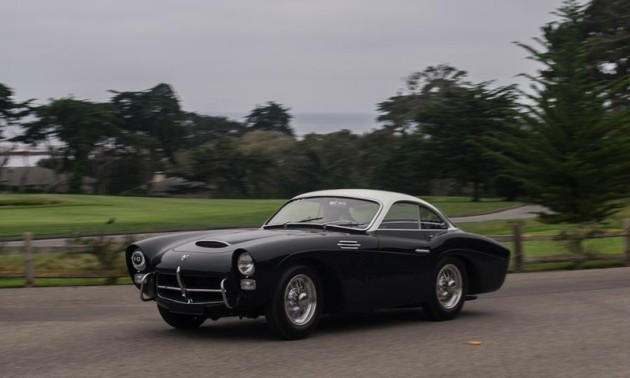
1954 Pegaso Z-102 Saoutchik Coupe
Le châssis conçu par Ricart est particulièrement original. En fait, il s’agit d’une plateforme semi monocoque constituée de plusieurs caissons en tôle d'acier emboutie et soudés entre eux. Pour la transmission, la Pegaso Z-102 adopte une boîte 5 rapports accolée au pont et recevant un différentiel à glissement limité. Les suspensions avant sont indépendantes par triangles superposés, les barres de torsion aux quatre roues, l'essieu arrière de Dion, les tambours de frein arrière accolés au pont et la colonne de direction télescopique réglable.
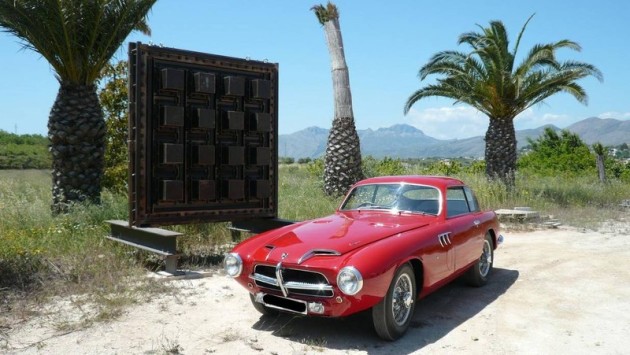
1955 Pegaso Z 102 Touring
Après quelques prototypes, la production des premières berlinettes Z102 démarre véritablement en 1952. Les voitures subissent de notables modifications techniques et esthétiques. La calandre arbore le blason de la marque dessiné en 1947 par Wifredo Ricart. Le moteur est proposé en trois variantes de cylindrée, 2,5 litres, 2,8 litres et 3,2 litres et en plusieurs taux de compression (7,8, 8,2 ou 8,8 à 1). Elle peut être également alimentée par un, deux ou quatre carburateurs Weber. Les puissances développées sont : 142 ch à 6000 tr/mn avec un carburateur Weber double corps pour le moteur 2,5 litres, 160 ch avec un Weber et 172 ch avec quatre Weber pour le 2,8 litres, 210 ch pour le moteur de 3,2 litres (couple de 25 mkg à 3500 tr/mn). Les Pegaso peuvent même recevoir un compresseur de type Roots, qui permet au V8 d’offrir plus de 280 ch (type Z102 BS). La vitesse atteint 200 km/h à 260 km/h selon la motorisation et le rapport de pont choisis, ce qui fait de la Pegaso la voiture commercialisée la plus rapide du monde avec la Ferrari 340 America.

1953 Pegaso Z 102 Touring
La Z-102 est réalisée en coupé deux places et en spider. Sur les 86 exemplaires de Pegaso produits, 22 ont été construits par l’usine ENASA dont les deux Bisiluro, 41 par Touring de Milan dont 25 berlinettes, 18 par Saoutchik de Paris et 5 par Serra de Barcelone. Touring est l’auteur d’un modèle expérimental et unique, la Thrill, à la ligne aérodynamique, présentée au Salon de Turin en 1953. En 1954, la marque espagnole expose au salon de Paris une Z102 à la carrosserie transparente réalisée en plexiglas sur base de coupé Touring. Présentée en 1955 aux Salons de Turin et de Paris, la Pegaso Z 103 Panoramica Touring est dotée d’un V8 16 soupapes de 3 178 cm3. Avec compresseur, la voiture atteint les 260 km/h.
Les coupés à caisse Superleggera de Touring étaient aussi les plus chers, vendus en quantité limitée aux plus fortunés et certains chefs d'Etat dont le Shah d'Iran, le président Craveiro Lopes du Portugal et le général Trujillo en République Dominicaine. A titre de comparaison, en 1956, une Pegaso Z 103 Panoramica coûtait environ 23 000 $ contre 3 500 $ pour une Chevrolet Corvette ou 6 000 $ pour une Cadillac Eldorado Biarritz.

1953 Pegaso Z 102 'Thrill' Touring.
Publié par Philippe Baron le 29 mars 2014.
Présentée au Salon de Paris 1951, la Pegaso Z 102 est la première voiture de l’après-guerre conçue et entièrement fabriquée en Espagne. Sa conception d’avant-garde relève de la technique sophistiquée de compétition mise au point par Wilfredo Ricart. L’ingénieur barcelonais tire ainsi profit de son expérience acquise chez Alfa Roméo à la fin des années 30. L’auto la plus chère du Grand Palais deviendra aussi en 1952 la voiture commercialisée la plus rapide au monde avec la Ferrari 340 America.

Pegaso Z 102 Cabriolet Saoutchik
En 1919, l’espagnol Wifredo Ricart, âgé de 22 ans, s’associe et fonde la marque Ricart et Perez. Il conçoit alors des voitures de course et de tourisme qui impressionneront Ugo Gobbato, ancien haut responsable de la Fiat, devenu le patron d’Alfa Romeo. Lorsque la marque au trèfle se lance dans un programme course intégré à l’entreprise, l’italien fait appel, non pas à Enzo Ferrari alors en charge de l’écurie de course rattachée à la marque, mais à Wilfredo Ricart qui dessinera la fameuse Tipo 512 à moteur central 12-cylindres de Grand Prix en 1940. De retour en Espagne après la guerre, l’INI (Institudo Nacional de Industria) lui propose de participer au plan de réorganisation de l’industrie automobile du pays. Une nouvelle entité est créée, l’ENASA (Empressa Nacional de Autocamiones) pour relancer en priorité la fabrique de camions et de bus sous la marque Pegaso. Parallèlement, Franco autorise à Ricart la création du CETA (Centro Technicos de Automocion) pour le projet d’une voiture de Grand Tourisme. C’est ainsi que nait le projet de la Z-102 (Z prononcé céta en espagnol) en référence au CETA et 102 pour deuxième projet.

1956 Pegaso Z 103 Panoramica - Photos : Julia LaPalme
La Pegaso Z-102 se révèle comme une routière aux caractéristiques mécaniques relevant de la compétition. D'une conception d'avant-garde, le V8 de 2.5 litres en aluminium est doté de soupapes d'échappement creuses au sodium (plus vite refroidies), de pistons en aluminium forgé, d'un graissage à carter sec et d’une distribution qui se fait par quatre arbres à cames en tête entraînés par pignons. La Pegaso reçoit selon le choix du client un ou deux carburateurs. Avec des cotes super carrées (75 x 70 mm), le V8 donne une cylindrée de 2 475 cm3 pour une puissance maximale de 165 ch à 6 500 tr/min.

1954 Pegaso Z-102 Saoutchik Coupe
Le châssis conçu par Ricart est particulièrement original. En fait, il s’agit d’une plateforme semi monocoque constituée de plusieurs caissons en tôle d'acier emboutie et soudés entre eux. Pour la transmission, la Pegaso Z-102 adopte une boîte 5 rapports accolée au pont et recevant un différentiel à glissement limité. Les suspensions avant sont indépendantes par triangles superposés, les barres de torsion aux quatre roues, l'essieu arrière de Dion, les tambours de frein arrière accolés au pont et la colonne de direction télescopique réglable.

1955 Pegaso Z 102 Touring
Après quelques prototypes, la production des premières berlinettes Z102 démarre véritablement en 1952. Les voitures subissent de notables modifications techniques et esthétiques. La calandre arbore le blason de la marque dessiné en 1947 par Wifredo Ricart. Le moteur est proposé en trois variantes de cylindrée, 2,5 litres, 2,8 litres et 3,2 litres et en plusieurs taux de compression (7,8, 8,2 ou 8,8 à 1). Elle peut être également alimentée par un, deux ou quatre carburateurs Weber. Les puissances développées sont : 142 ch à 6000 tr/mn avec un carburateur Weber double corps pour le moteur 2,5 litres, 160 ch avec un Weber et 172 ch avec quatre Weber pour le 2,8 litres, 210 ch pour le moteur de 3,2 litres (couple de 25 mkg à 3500 tr/mn). Les Pegaso peuvent même recevoir un compresseur de type Roots, qui permet au V8 d’offrir plus de 280 ch (type Z102 BS). La vitesse atteint 200 km/h à 260 km/h selon la motorisation et le rapport de pont choisis, ce qui fait de la Pegaso la voiture commercialisée la plus rapide du monde avec la Ferrari 340 America.

1953 Pegaso Z 102 Touring
La Z-102 est réalisée en coupé deux places et en spider. Sur les 86 exemplaires de Pegaso produits, 22 ont été construits par l’usine ENASA dont les deux Bisiluro, 41 par Touring de Milan dont 25 berlinettes, 18 par Saoutchik de Paris et 5 par Serra de Barcelone. Touring est l’auteur d’un modèle expérimental et unique, la Thrill, à la ligne aérodynamique, présentée au Salon de Turin en 1953. En 1954, la marque espagnole expose au salon de Paris une Z102 à la carrosserie transparente réalisée en plexiglas sur base de coupé Touring. Présentée en 1955 aux Salons de Turin et de Paris, la Pegaso Z 103 Panoramica Touring est dotée d’un V8 16 soupapes de 3 178 cm3. Avec compresseur, la voiture atteint les 260 km/h.
Les coupés à caisse Superleggera de Touring étaient aussi les plus chers, vendus en quantité limitée aux plus fortunés et certains chefs d'Etat dont le Shah d'Iran, le président Craveiro Lopes du Portugal et le général Trujillo en République Dominicaine. A titre de comparaison, en 1956, une Pegaso Z 103 Panoramica coûtait environ 23 000 $ contre 3 500 $ pour une Chevrolet Corvette ou 6 000 $ pour une Cadillac Eldorado Biarritz.
_________________
We don't care the People Says , Rock 'n' roll is here to stay - Danny & the Juniors - 1958
 Re: Pegaso Z 102 (1951-1958)
Re: Pegaso Z 102 (1951-1958)
_________________
We don't care the People Says , Rock 'n' roll is here to stay - Danny & the Juniors - 1958
 Re: Pegaso Z 102 (1951-1958)
Re: Pegaso Z 102 (1951-1958)
_________________
We don't care the People Says , Rock 'n' roll is here to stay - Danny & the Juniors - 1958
 Re: Pegaso Z 102 (1951-1958)
Re: Pegaso Z 102 (1951-1958)
_________________
We don't care the People Says , Rock 'n' roll is here to stay - Danny & the Juniors - 1958
 Re: Pegaso Z 102 (1951-1958)
Re: Pegaso Z 102 (1951-1958)
Dernière édition par Predicta le Sam 27 Déc - 22:36, édité 1 fois
_________________
We don't care the People Says , Rock 'n' roll is here to stay - Danny & the Juniors - 1958
 Re: Pegaso Z 102 (1951-1958)
Re: Pegaso Z 102 (1951-1958)
J'ai toujours trouvé ça bonnard, les Pegaso !
_________________
Rien ne vaut le son du V8 le soir au coin du bois.
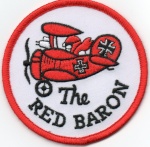
The Red Baron- Messages : 741
Date d'inscription : 01/07/2014
Age : 55
Localisation : Bordeaux
 Re: Pegaso Z 102 (1951-1958)
Re: Pegaso Z 102 (1951-1958)
_________________
We don't care the People Says , Rock 'n' roll is here to stay - Danny & the Juniors - 1958
 Re: Pegaso Z 102 (1951-1958)
Re: Pegaso Z 102 (1951-1958)
_________________
We don't care the People Says , Rock 'n' roll is here to stay - Danny & the Juniors - 1958
 Re: Pegaso Z 102 (1951-1958)
Re: Pegaso Z 102 (1951-1958)
_________________
We don't care the People Says , Rock 'n' roll is here to stay - Danny & the Juniors - 1958
 Re: Pegaso Z 102 (1951-1958)
Re: Pegaso Z 102 (1951-1958)
_________________
We don't care the People Says , Rock 'n' roll is here to stay - Danny & the Juniors - 1958
 Re: Pegaso Z 102 (1951-1958)
Re: Pegaso Z 102 (1951-1958)
_________________
We don't care the People Says , Rock 'n' roll is here to stay - Danny & the Juniors - 1958
 Re: Pegaso Z 102 (1951-1958)
Re: Pegaso Z 102 (1951-1958)
Pegaso Z-102
Pegaso was an established company noted for its trucks and motor coaches, but also produced sports cars for seven years. Pegaso chief technical manager by then was Wifredo Ricart, former designer of the Alfa Romeo 512, and fellow rival of Enzo Ferrari, who at the time had also worked for Alfa Romeo.
The Z-102 employed racing-car technology in its chassis and alloy body. Everything was produced in-house at Barcelona, where the Pegaso cars factory was, with the exception of the external coachworking, either by Carrozzeria Touring, Saoutchik or Serra (although early Z-102 units carry Pegaso-made bodies). A four-cam all-alloy V8 engine, dry-sump lubrication, and a 5-speed non-syncronmesh gearbox mounted with the differential as a unit were within a pressed steel chassis.

1952 Pegaso Z-102 brochure cover.
The Z-102 started life as two prototypes in 1951 as a coupe and a drophead. The coupe and convertible had dumpy steel bodies, and weight was an issue to the extent that Pegaso made the decision to revert to alloy for the coachwork. Coachbuilder Touring then 'beautified' the design, replacing the grille with a two-piece cross, lowering the car, repositioning the foglights, and simplifying various details to give it a clean profile, similar to the contemporary Aston Martin DB2 and the Lancia Aurelia, that was the most memorable and numerous of all Z-102 bodies.
The Z102 entered production with a 2.5 (2472cc) litre engine as used in the prototypes, though later there were variants with 2.8 (2816cc), and 3.2 (3178cc) litre DOHC desmodromic 32-valve V8 360 hp (270 kW) engines with multiple carburetors or optional supercharger. Horsepower ranged from 175 to 360, and, transferred through a five-speed gearbox and gear-driven camshaft, the fastest could reach 155 miles per hour (249 km/h), exceeding Ferrari autos, thus making it the world's fastest production car at the time.[1] The base model had an 120 mph (192 km/h) top speed.
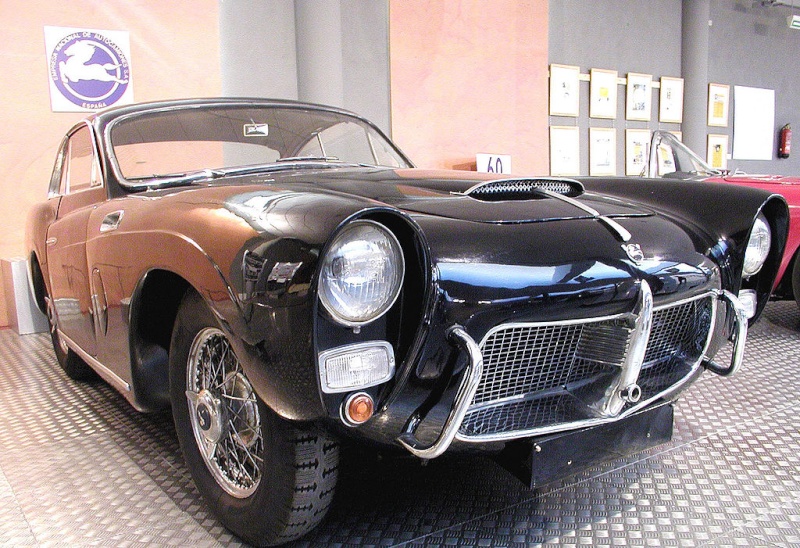
Pegaso Z-102 bodied by Saoutchik.
The main beams of the car's frame had large lightening holes, and the wheel wells under the body were used as stressed members.
This rear-wheel-drive car had its transmission in the rear, connected to the differential (making it a transaxle). But it was unusually located behind the differential within a reverse A-frame whose apex was at the rear of the chassis. A fuel tank was situated on each side of the transmission.
The rear suspension was of the De Dion type, with the unusual feature that, to restrain the tube from side-to-side movement, its tube had a small wheel at its midpoint that rolled in a vertical channel on the front of the differential (which in a De Dion system is bolted to the chassis) instead of using a Watts linkage or a Panhard rod.
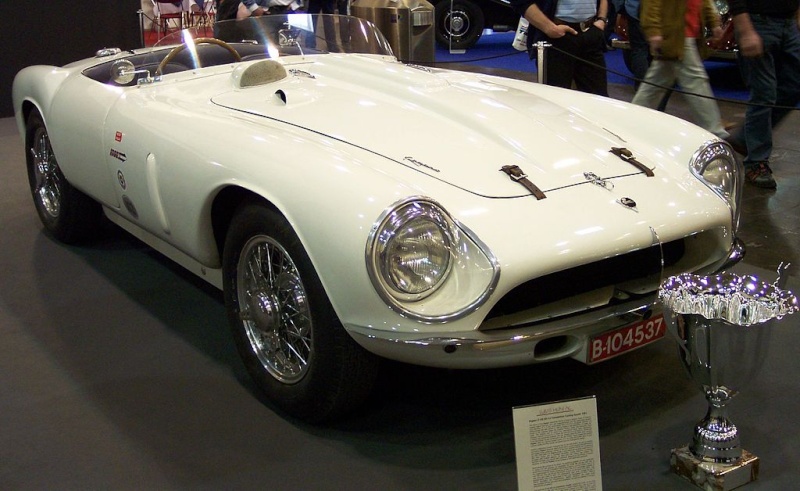
Pegaso Z-102 BS 3.2 Competition Touring Spyder.
However, the cars were heavy and brutish to drive and competition success was virtually nonexistent. Because the cars were built on a cost-no-object basis, this caused financial difficulty in the company. A simplified and cheaper version, the Z-103 with 3.9, 4.5 and 4.7 litre engines, was put into production, but to no avail, and the Z-102 was discontinued after 1958. Just 86 cars were produced, and out of these, only a handful of cabriolets were built.
The Pegasos raced in several competitions, but with no real success. In the 1953 Le Mans trials, driver Juan Jover was seriously injured after crashing at more than 200 km/h. They competed also in the 1954 Carrera Panamericana, driven by Joaquin Palacio, with increasingly promising results in the first stages, but again an accident prevented an excellent final position.
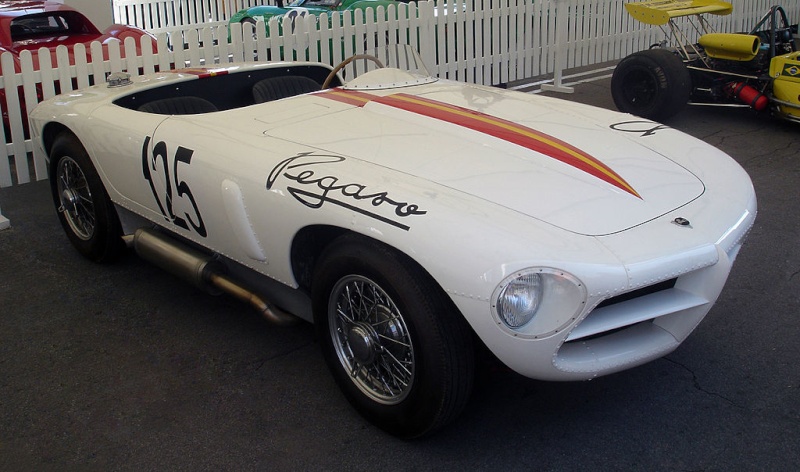
Pegaso Z-102 Spider Rabasada, 1953.
Furthermore, on September 25, 1953, in Jabbeke (Belgium), a Z-102 Touring BS/2.8 (the old Barchetta used at Le Mans, 2.8 litre single supercharger), driven by Celso Fernández, broke four official R.A.C.B. (Royal Automobile Club de Belgique) worldwide records (fastest of them, 243.079 km/h (= 151.042 mph) average in the flying-start kilometer), previously owned by a Jaguar XK120. The original Z-102 BSS/2.5 Bisiluro Especial Competición (2.5 litre twin supercharged) meant to take on the records couldn't be used because of a blown engine.
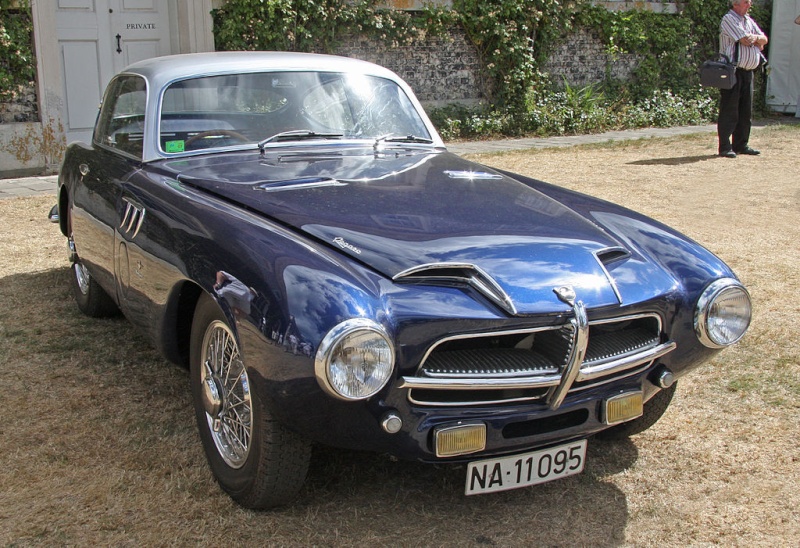
1955 Pegaso Z-102B Touring Berlinetta Superleggera at the Goodwood Festival of Speed
Pegasos achieved much better results in several Concours d'Elegance contests. A Pegaso Z-102 coupé by Saoutchick, owned by Baron Thyssen-Bornemisza, was in this respect the epitome of coachwork sophistication, as it had seats upholstered with leopard skin and controls in gold, and in such a finish it won the 1953 Enghien-les-Bains (France) Grand Prix d'Elegance.
http://en.wikipedia.org/wiki/Pegaso_Z-102
Pegaso was an established company noted for its trucks and motor coaches, but also produced sports cars for seven years. Pegaso chief technical manager by then was Wifredo Ricart, former designer of the Alfa Romeo 512, and fellow rival of Enzo Ferrari, who at the time had also worked for Alfa Romeo.
The Z-102 employed racing-car technology in its chassis and alloy body. Everything was produced in-house at Barcelona, where the Pegaso cars factory was, with the exception of the external coachworking, either by Carrozzeria Touring, Saoutchik or Serra (although early Z-102 units carry Pegaso-made bodies). A four-cam all-alloy V8 engine, dry-sump lubrication, and a 5-speed non-syncronmesh gearbox mounted with the differential as a unit were within a pressed steel chassis.

1952 Pegaso Z-102 brochure cover.
The Z-102 started life as two prototypes in 1951 as a coupe and a drophead. The coupe and convertible had dumpy steel bodies, and weight was an issue to the extent that Pegaso made the decision to revert to alloy for the coachwork. Coachbuilder Touring then 'beautified' the design, replacing the grille with a two-piece cross, lowering the car, repositioning the foglights, and simplifying various details to give it a clean profile, similar to the contemporary Aston Martin DB2 and the Lancia Aurelia, that was the most memorable and numerous of all Z-102 bodies.
The Z102 entered production with a 2.5 (2472cc) litre engine as used in the prototypes, though later there were variants with 2.8 (2816cc), and 3.2 (3178cc) litre DOHC desmodromic 32-valve V8 360 hp (270 kW) engines with multiple carburetors or optional supercharger. Horsepower ranged from 175 to 360, and, transferred through a five-speed gearbox and gear-driven camshaft, the fastest could reach 155 miles per hour (249 km/h), exceeding Ferrari autos, thus making it the world's fastest production car at the time.[1] The base model had an 120 mph (192 km/h) top speed.

Pegaso Z-102 bodied by Saoutchik.
The main beams of the car's frame had large lightening holes, and the wheel wells under the body were used as stressed members.
This rear-wheel-drive car had its transmission in the rear, connected to the differential (making it a transaxle). But it was unusually located behind the differential within a reverse A-frame whose apex was at the rear of the chassis. A fuel tank was situated on each side of the transmission.
The rear suspension was of the De Dion type, with the unusual feature that, to restrain the tube from side-to-side movement, its tube had a small wheel at its midpoint that rolled in a vertical channel on the front of the differential (which in a De Dion system is bolted to the chassis) instead of using a Watts linkage or a Panhard rod.

Pegaso Z-102 BS 3.2 Competition Touring Spyder.
However, the cars were heavy and brutish to drive and competition success was virtually nonexistent. Because the cars were built on a cost-no-object basis, this caused financial difficulty in the company. A simplified and cheaper version, the Z-103 with 3.9, 4.5 and 4.7 litre engines, was put into production, but to no avail, and the Z-102 was discontinued after 1958. Just 86 cars were produced, and out of these, only a handful of cabriolets were built.
The Pegasos raced in several competitions, but with no real success. In the 1953 Le Mans trials, driver Juan Jover was seriously injured after crashing at more than 200 km/h. They competed also in the 1954 Carrera Panamericana, driven by Joaquin Palacio, with increasingly promising results in the first stages, but again an accident prevented an excellent final position.

Pegaso Z-102 Spider Rabasada, 1953.
Furthermore, on September 25, 1953, in Jabbeke (Belgium), a Z-102 Touring BS/2.8 (the old Barchetta used at Le Mans, 2.8 litre single supercharger), driven by Celso Fernández, broke four official R.A.C.B. (Royal Automobile Club de Belgique) worldwide records (fastest of them, 243.079 km/h (= 151.042 mph) average in the flying-start kilometer), previously owned by a Jaguar XK120. The original Z-102 BSS/2.5 Bisiluro Especial Competición (2.5 litre twin supercharged) meant to take on the records couldn't be used because of a blown engine.

1955 Pegaso Z-102B Touring Berlinetta Superleggera at the Goodwood Festival of Speed
Pegasos achieved much better results in several Concours d'Elegance contests. A Pegaso Z-102 coupé by Saoutchick, owned by Baron Thyssen-Bornemisza, was in this respect the epitome of coachwork sophistication, as it had seats upholstered with leopard skin and controls in gold, and in such a finish it won the 1953 Enghien-les-Bains (France) Grand Prix d'Elegance.
http://en.wikipedia.org/wiki/Pegaso_Z-102
_________________
We don't care the People Says , Rock 'n' roll is here to stay - Danny & the Juniors - 1958
 Re: Pegaso Z 102 (1951-1958)
Re: Pegaso Z 102 (1951-1958)
_________________
We don't care the People Says , Rock 'n' roll is here to stay - Danny & the Juniors - 1958
 Sujets similaires
Sujets similaires» Pegaso Z-102 2,8 Cabriolet RH by Saoutchik. 1954
» 1958 Chevrolet - Scoopy Doo - Chevy 1958 - Joe Bailon
» 1951 Ford - The X-51
» Radio Zenith
» Studebaker custom & mild custom
» 1958 Chevrolet - Scoopy Doo - Chevy 1958 - Joe Bailon
» 1951 Ford - The X-51
» Radio Zenith
» Studebaker custom & mild custom
Permission de ce forum:
Vous ne pouvez pas répondre aux sujets dans ce forum|
|
|

 Connexion
Connexion


